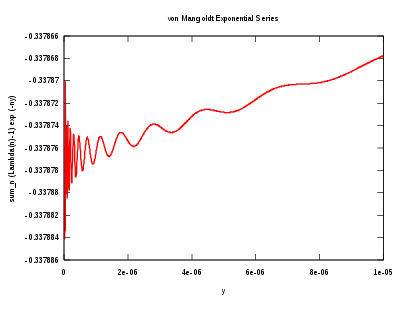Von Mangoldt function
In mathematics, the von Mangoldt function is an arithmetic function named after German mathematician Hans von Mangoldt. It is an example of an important arithmetic function that is neither multiplicative nor additive.
Definition
The von Mangoldt function, denoted by Λ(n), is defined as
The values of Λ(n) for the first nine positive integers (i.e. natural numbers) are
which is related to (sequence A014963 in the OEIS).
The summatory von Mangoldt function, ψ(x), also known as the second Chebyshev function, is defined as
Von Mangoldt provided a rigorous proof of an explicit formula for ψ(x) involving a sum over the non-trivial zeros of the Riemann zeta function. This was an important part of the first proof of the prime number theorem.
Properties
The von Mangoldt function satisfies the identity[1][2]
The sum is taken over all integers d that divide n. This is proved by the fundamental theorem of arithmetic, since the terms that are not powers of primes are equal to 0. For example, consider the case n = 12 = 22 × 3. Then
By Möbius inversion, we have[2][3][4]
Dirichlet series
The von Mangoldt function plays an important role in the theory of Dirichlet series, and in particular, the Riemann zeta function. For example, one has
The logarithmic derivative is then[5]
These are special cases of a more general relation on Dirichlet series. If one has
for a completely multiplicative function f (n), and the series converges for Re(s) > σ0, then
converges for Re(s) > σ0.
Chebyshev function
The second Chebyshev function ψ(x) is the summatory function of the von Mangoldt function:[6]
The Mellin transform of the Chebyshev function can be found by applying Perron's formula:
which holds for Re(s) > 1.
Exponential series

Hardy and Littlewood examined the series[7]
in the limit y → 0+. Assuming the Riemann hypothesis, they demonstrate that
In particular this function is oscillatory with diverging oscillations: there exists a value K > 0 such that both inequalities
hold infinitely often in any neighbourhood of 0. The graphic to the right indicates that this behaviour is not at first numerically obvious: the oscillations are not clearly seen until the series is summed in excess of 100 million terms, and are only readily visible when y < 10−5.
Riesz mean
The Riesz mean of the von Mangoldt function is given by
Here, λ and δ are numbers characterizing the Riesz mean. One must take c > 1. The sum over ρ is the sum over the zeroes of the Riemann zeta function, and
can be shown to be a convergent series for λ > 1.
Approximation by Riemann zeta zeros

The real part of the sum over the zeta zeros:
- , where ρ(i) is the i-th zeta zero, peaks at primes, as can be seen in the adjoining graph, and can also be verified through numerical computation. It does not sum up to the Von Mangoldt function.[8]
The Fourier transform of the von Mangoldt function gives a spectrum with spikes at ordinates equal to the imaginary parts of the Riemann zeta function zeros. This is sometimes called a duality.
See also
References
- Apostol (1976) p.32
- Tenenbaum (1995) p.30
- Apostol (1976) p.33
- Schroeder, Manfred R. (1997). Number theory in science and communication. With applications in cryptography, physics, digital information, computing, and self-similarity. Springer Series in Information Sciences. 7 (3rd ed.). Berlin: Springer-Verlag. ISBN 3-540-62006-0. Zbl 0997.11501.
- Hardy & Wright (2008) §17.7, Theorem 294
- Apostol (1976) p.246
- Hardy, G. H. & Littlewood, J. E. (1916). "Contributions to the Theory of the Riemann Zeta-Function and the Theory of the Distribution of Primes" (PDF). Acta Mathematica. 41: 119–196. doi:10.1007/BF02422942. Archived from the original (PDF) on 2012-02-07. Retrieved 2014-07-03.
- Conrey, J. Brian (March 2003). "The Riemann hypothesis" (PDF). Notices Am. Math. Soc. 50 (3): 341–353. Zbl 1160.11341. Page 346
- Apostol, Tom M. (1976), Introduction to analytic number theory, Undergraduate Texts in Mathematics, New York-Heidelberg: Springer-Verlag, ISBN 978-0-387-90163-3, MR 0434929, Zbl 0335.10001
- Hardy, G. H.; Wright, E. M. (2008) [1938]. Heath-Brown, D. R.; Silverman, J. H. (eds.). An Introduction to the Theory of Numbers (6th ed.). Oxford: Oxford University Press. ISBN 978-0-19-921985-8. MR 2445243. Zbl 1159.11001.
- Tenebaum, Gérald (1995). Introduction to analytic and probabilistic number theory. Cambridge Studies in Advanced Mathematics. 46. Translated by C.B. Thomas. Cambridge: Cambridge University Press. ISBN 0-521-41261-7. Zbl 0831.11001.
External links
- Allan Gut, Some remarks on the Riemann zeta distribution (2005)
- S.A. Stepanov (2001) [1994], "Mangoldt function", Encyclopedia of Mathematics, EMS Press
- Chris King, Primes out of thin air (2010)
- Heike, How plot Riemann zeta zero spectrum in Mathematica? (2012)